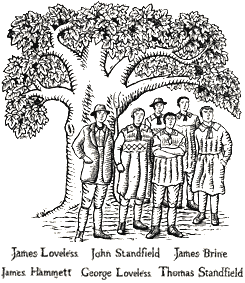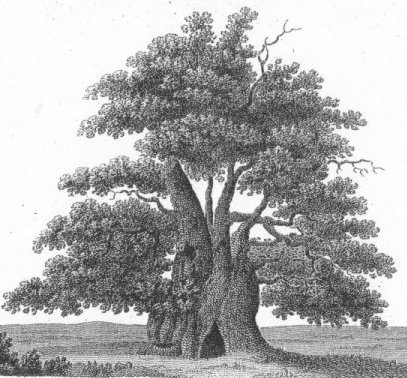
Tricky one this. Although at various times there have indeed been seven oaks planted in Sevenoaks, all of those referred to in records seem to be predated by the town. As recently as 1902, seven oaks were planted around the Vine cricket ground (which dates back to 1773 and is the first place in England where a game of cricket was played with three stumps instead of two). These seem to be replacements – contemporary paintings and photography from 1900 depict 'The Seven Oaks' at the same location. After the Great Storm of 1987, all but one of the 1902 trees were uprooted. The six felled trees were replaced, but after vandalism and more replanting, there are now – rather confusingly – nine oaks on the site.
Local lore states that the town was named after a Saxon chapel called Seouenaca in the grounds of Knole Park. It is possible that this name is in fact derived from the fact that seven oaks stood near the chapel in about 800 AD. (The Middle English for seven is recorded both as 'seofan' and 'seouen'.) However, it wasn't until the 13th Century that a market town is recorded as existing around the Knole estate.
And then there's Sir William Sennoke or Sevenoke, who became Lord Mayor of London in 1418 and whose life followed almost as many twists and turns as the man who replaced him as Lord Mayor the following year – Dick Whittington.
Legend has it he was discovered by Sir William de Romschedde as an orphan under seven oaks near the small hamlet of Riverhill in Kent. After serving as an apprentice grocer in London, he became first Sheriff and then Lord Mayor of London, and amassed considerable personal wealth, which he used to fund 20 almshouses as well as a free school in 1432 (originally Queen Elizabeth's Grammar School, now Sevenoaks School) "at Seven-oaks". Although the school is now far from longer free, Sir William's charity still lives on in the form of scholarships.
So, to recap: there are plenty of oaks in Sevenoaks. At various times since 800 AD there have been seven in a group, varying in location from Knole Park, Riverhill and The Vine. Which ones the town are named after is uncertain – but it's unlikely, sadly, that any are still standing.











